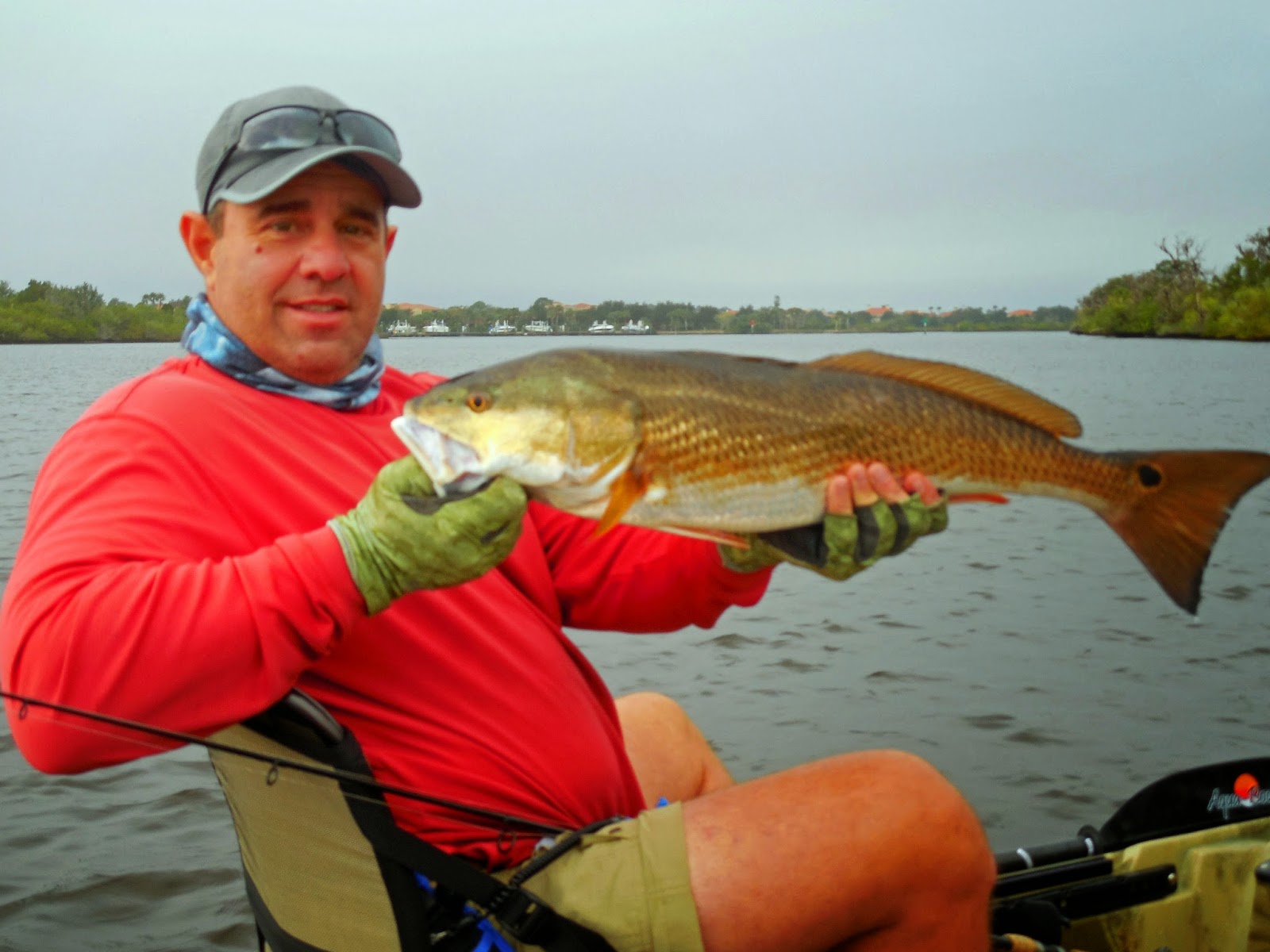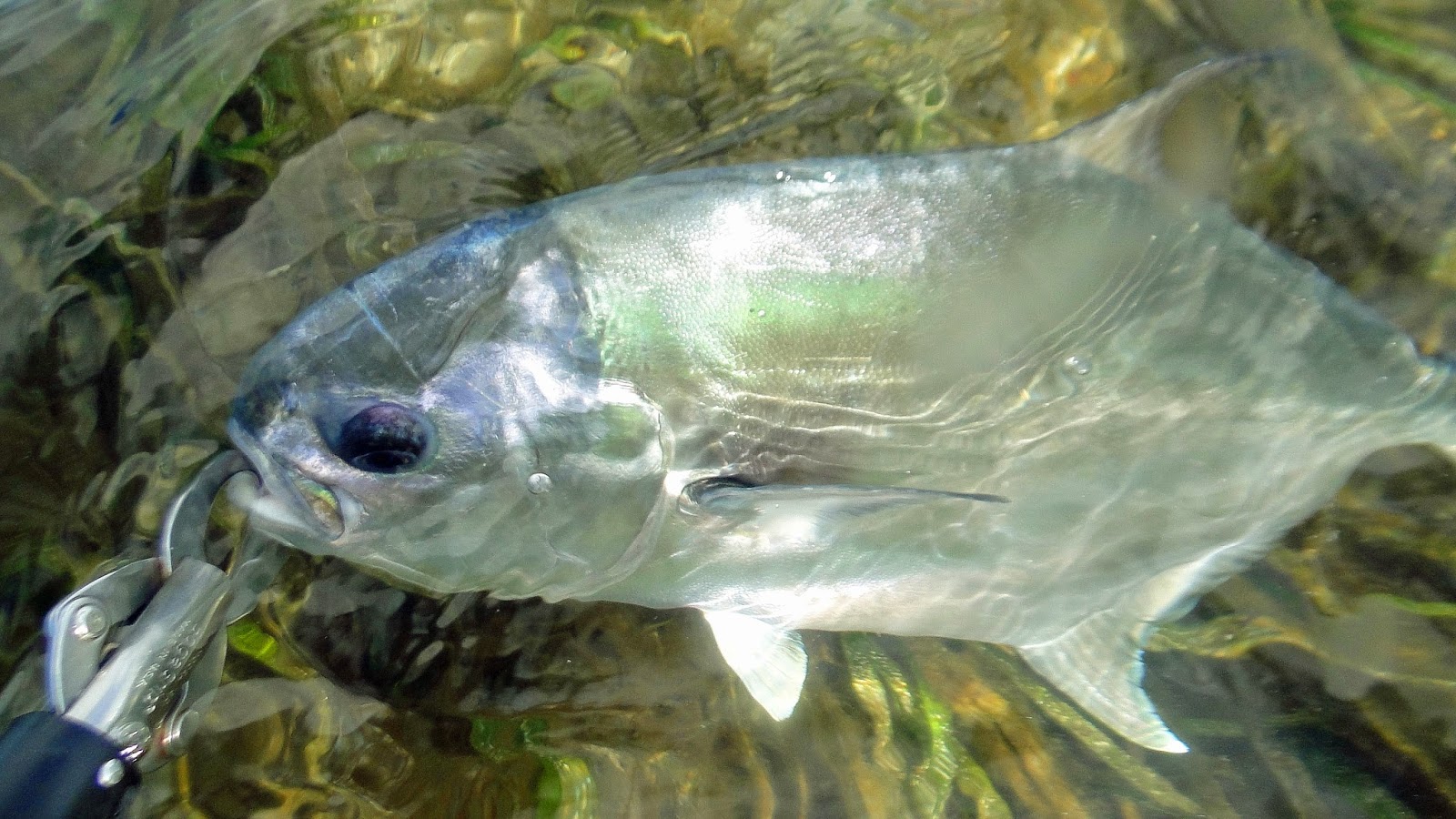 |
| The author used a Lil John on a 1/16-ounce jig to nab this hefty Myakka River snook. |
We all have our favorite lures.
I have mine.
In fact, I could carry my arsenal of favorites in my shirt pocket.
 |
| Dave Robinson shows off his largest snook ever. |
When I head for a saltwater fishing trip, I carry an assortment of
MirrOlures: MirrOdines, Lil Johns and She Dogs.
That's about all I need.
I believe the MirrOdine just might be the best lure for big trout
that I've ever used. In 2012, my clients and I landed 56 spotted seatrout of 5
pounds or more, including a large trout of 9 pounds.
That might not raise eyebrows on Florida's east coast, but I
consider it impressive here on the west coast.
 |
| Tarpon love Lil Johns, too! |
I had a morning when the smallest trout I landed weighed 6 pounds.
I don't know what it is about the MirrOdine, but it certainly is a
fish-producer.
I prefer the "mini" MirrOdines. I'm sure the smaller
version was designed to be fished when the new batch of white bait shows up
each year. But I've found the "mini" model works well year round.
I've also taken my share of big trout on the regular model.
When I'm targeting big trout, I use a light Star spinning rod,
Shimano Stradic Cl4 reel and 5-pound test PowerPro. I employ very little drag
on the reel, preferring to use my fingers and palm to add drag as need. My
reason for doing this is that trout have a "soft" mouth and the
violent struggles of a large trout often are enough to rip the hooks right out
of its mouth.
 |
| Vinny Caruso used a MirrOdine to nab this redfish. |
So, I've found a soft rod, light line and light drag to be
essential. It takes a soft, delicate touch when it comes to large trout.
One of the most important factors for me is to work the MirrOdine
slowly. I hold my rod horizontally over the water to my left side (I'm
right-handed). After casting, I retrieve any slack in the line, then twitch the
lure with the rod tip. I repeat the procedure throughout the retrieve. I may
vary the retrieve, twitching twice, then once.
Most of the strikes take place during the pause.
That's the beauty of a suspending lure. When you pause, it won't
sink to the bottom like a lead weight.
It suspends tantalizingly in front of the fish.
 |
| This pompano ate a MirrOdine. |
While the MirrOdine certainly appeals to large trout, I've found
that pompano can't resist it, either. Over my last two trips, I taken 20 pompano
from Sarasota Bay on MirrOdines.
In the past, I've always used jigs when targeting pompano. I don't
think many people will argue with that logic. And I've got to admit that I
wouldn't typically use a MirrOdine when it comes to pompano.
But my thinking has been altered. I think the MirrOdine is a great
pompano lures.
And last summer, I landed two permit from Sarasota Bay on the
MirrOdine.
Of course, other fish love them, too. I can't tell you how many
redfish I've taken on MirrOdines. I've caught redfish on them while casting for
trout. I've also taken many redfish by casting the lure into mullet schools on
the grass flats. Redfish love to hang out around mullet. And they love the
MirrOdine.
Snook absolutely go nuts over MirrOdines. I love to wade along the
edge of a grass flat at low tide, casting parallel to the dropoff. That's where
I hook a majority of snook.
And, of course, you'll catch bluefish, jack crevalle, Spanish
mackerel and many other saltwater species on the MirrOdine.
If I'm targeting redfish on the flats, I like to rig with a
1/16-ounce jig head and Lil John.
I have to admit that when Eric Bachnik of MirrOlure sent me a pack
of them a few years ago, I was suspect. Lil Johns are rather non-descript
pieces of plastic. But they come in a variety of fish-catching colors and, most
importantly, they catch lots of fish.
I usually use one of several colors: golden bream, watermelon with
red glitter, watermelon with copper glitter and purple demon.
I've found that I can use that combo in even very shallow, grassy
water. I take a majority of my redfish on the Lil John.
The Lil John also is great when it comes to prospecting for
redfish in potholes.
Now when it comes to monster snook, the Lil John is money. I taken
clients to local rivers in winter to pursue giant snook. Every rod has a Lil
John and light jig head tied to it.
For river fishing, I love the watermelon with red glitter Lil
John.
The trick for big snook is to target deep water and to allow the
lure to get to the bottom. I try to bounce it slowly along the bottom.
We have taken snook up to 44 inches and many of more than 30
inches.
When targeting redfish and big snook, I use a medium-heavy Star
Rod, Shimano Stradic 3000 Cl4 reel and 15-pound PowerPro. I use 30-pound
fluorocarbon leader in the river for big snook. For redfish on the flats, I use
20-pound leader.
When the topwater bite is strong or when I'm
"prospecting," I like the She Dog with the chartreuse back, chrome
body and orange throat (CRGR).
When using any topwater lure of this sort, it's imperative to know
how to "walk the dog" correctly. That's a retrieve in which the lure
works side-to-side during the retrieve.
I like to hold my rod horizontally to my left side (I'm right-handed),
and "twitch" my rod during the retrieve in a steady rhythm. It's much
like patting your head and rubbing your stomach, but becomes second nature with
practice.
As with any topwater lure, it's imperative not to set the hook on
the strike. Just keep working the lure until you feel the weight on the fish.
Then set the hook.
My association with MirrOlure goes back to the early 1970s when I
was just starting out in the newspaper business. I heard shortly after I moved
to Sarasota to begin work as the outdoors editor of the old Sarasota Journal
that Harold LeMaster was the man when it came to tarpon along Florida's west
coast. I mustered up some courage and called Harold at his plant in Largo. I
was terrified.
But Harold was very nice and agreed to drive down and fish for
tarpon with me.
It was one of several trips I made with him over the years. He
even took me to Homosassa, the tarpon Mecca, long before the work got out about
the great tarpon fishing there.
He wouldn't tell me where we were going. He just called it
"Hog Heaven."
As with any lure, I don't use MirrOlures because I get them for
free or at a reduced price.
I use them because they produce fish for me consistently.
What more do you need?
